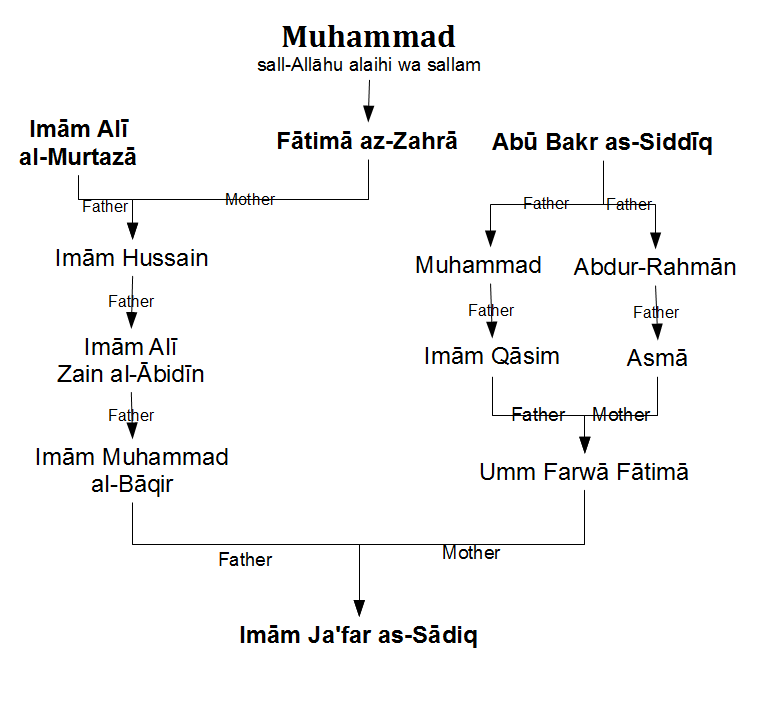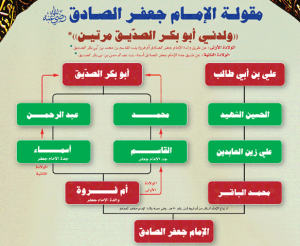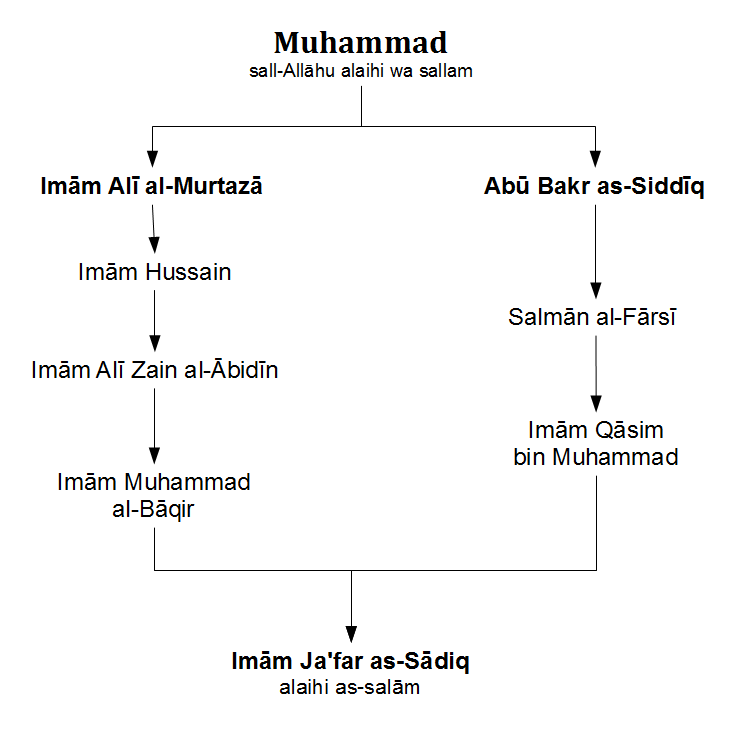Hazrat Sayyidinā Imām Ja’far as-Sādiq raziyallahu anhu (80-148 AH) was the sixth Imam of the twelve Imams of Ahl al-Bayt and one of the greatest Tābi’een. He was the heir to the throne of sainthood of his grandfather Imam Ali, and also the inheritor of the spiritual empire of his maternal grandfather Sayyidina Abū Bakr as-Siddīq.
He was the son and successor of Imam Muhammad al-Bāqir, who was son of Imam Zain al-Ābideen, son of Imam Hussain, son of Imam Alī al-Murtazā, may Allah be pleased with them all. His mother was Sayyida Umm Farwā Fātimā bint Imam Qāsim bin Muhammad. His maternal grandfather was Imam Qāsim bin Muhammad bin Abū Bakr, the grandson of Sayyidina Abū Bakr as-Siddīqraziyallahu anhum. His maternal grandmother was Asmā bint Abdur-Rahmān bin Abū Bakr, also a granddaughter of Sayyidina Abū Bakr. Thus he is reported to have said that “I was born by Abu Bakr twice”, referring to his maternal grandparents who were cousins and grandchildren of Sayyidina Abu Bakr. Imam Rabbani Shaykh Ahmed Sirhindi says in his Maktūbat that this may also refer to the fact that he was born in the noble family of Abū Bakr both physically and spiritually, as he received the spiritual secret of Sayyidina Abū Bakr as-Siddīq from his grandfather Imam Qāsim bin Muhammad.
He was born in 80 AH. His exact date of birth is differed upon, with Imam Bukhari reporting that he was born on 17th Rabi al-Awwal (23/24 May 699), some others reporting 8th Ramadān (5/6 November).
He remained under training of his grandfather Imam Zain al-Abideen for 14 years, under his father’s training for 34 years, and under his maternal grandfather’s training for 27 years. He also met some of the Sahaba who were living at that time, and received spiritual secrets from them. Thus he is considered one of the greatest Tābi’een.
Imam Rabbani writes about this pole of spirituality in his Maktūbat (letters) as follows:
And Hazrat Siddīq raziyallahu anhu, by virtue of the utmost sincerity cherished for His Prophetship sall-Allahu alaihi wa sallam, and being annihilated in him, stands distinguished by this special path amongst all other Companions rizwan-Allahi alaihim ajma’een. And this very Reference [Nisbah, spiritual connection] of passion and travelling has reached Hazrat Imām Jāfar Sādiq with this very speciality. And since the mother of the Imām came of the noble descendants of Hazrat Siddiq Akbar raziyallahu anhum, therefore, in view of each of the two sides, the Imām has said: “abu-Bakr gave me birth twice”. And since the Imām were possessed of a different Reference [Nisbah] from his noble ancestors, [he] became thus a combiner of the two paths and gathered that passion (jazbah) with their travelling (suluk), and by this travelling attained to the Goal. The difference between these two travellings is this that the travelling of Hazrat Amir [Imam Ali raziyallahu anhu] comes to be accomplished through horizonward journey (sairi āfāqi), while the travelling of Hazrat Siddiq raziyallahu anhu has no connection with that of the horizonward (āfāqi). It is as [to] make a hole through the region of passion and convey to the Object of Desire. In the first travelling is acquisition of gnoses, and in the second, domination of love. Inevitably thus, Hazrat Amir came to be the doorway of the City of Knowledge (bābi Madīnatul Ilm) while Hazrat Siddiq acquired the ability of friendship towards His Prophetship alaihi is-salāt wassalām. [The Prophet] said: “If I were to take one for a friend, verily would take abu-Bakr for friend”. And Hazrat Imām in view of the comprehensiveness of the passion-side, the basis whereof is love, and of the horizonward-travelling-side, which is a source of cognitions and gnoses, obtained abundance of fortune of love and gnosis. Afterwards the Imām entrusted the Sultān-ul-Ārifīn quddisa sirruhū with this Compound Reference (Nisbati Murakkab) as a deposit.
[Maktūb 290 in volume 1, translated by Sheykh Muhammad Wajihuddin, with my annotations in square brackets.]
He lived most of his life in Madinah, though for several years he stayed in Iraq. He passed away on 15 Rajab 148 AH (6/7 September 765) in Madinah al-Munawwarah, and was buried in al-Baqi close to his grandfathers.
From his famous students were the following:
- Imām Mūsā al-Kāzim (his son)
- Imam Abū Hanīfā, founder of the Hanafi school of fiqh
- Imam Mālik bin Anas, founder of the Maliki school of fiqh
- Imam Sufyān a-Thawrī, founder of the Thawri school of fiqh
- Khwaja Dāūd Tāī, a great Sufi master
- Jabir ibn Hayyān, famous alchemist and founder of the experimental chemistry
His spiritual legacy was transferred to numerous scholars and Sufi masters of the Ummah, including Imam Abū Hanīfā who stayed with him for two years. The secret of the Siddiqi spirituality was transferred from him after his death toSultān al-Ārifeen Bāyazīd al-Bustāmī, and is the main spiritual connection of the Naqshbandi Sufi order.
The next in the Naqshbandī Mujaddidī Tāhirī spiritual golden chain is Shaykh Bāyazīd al-Bustāmī.


